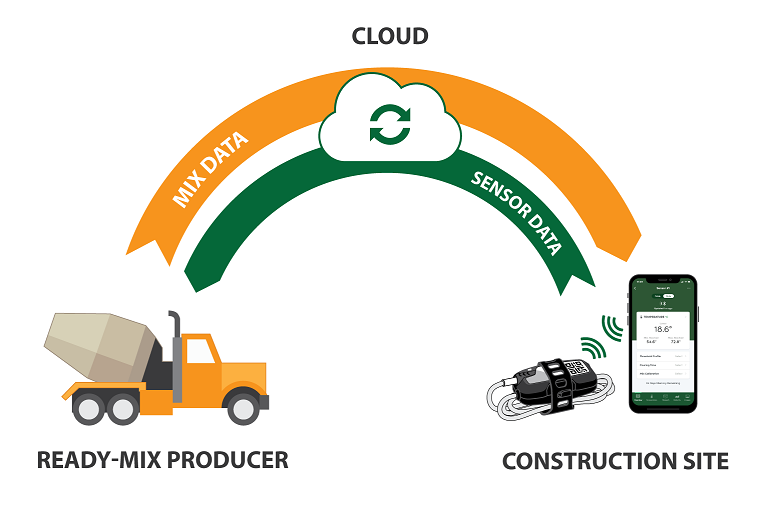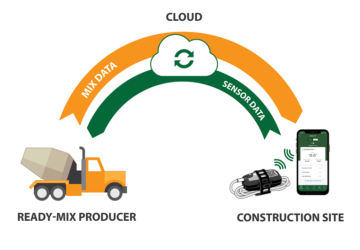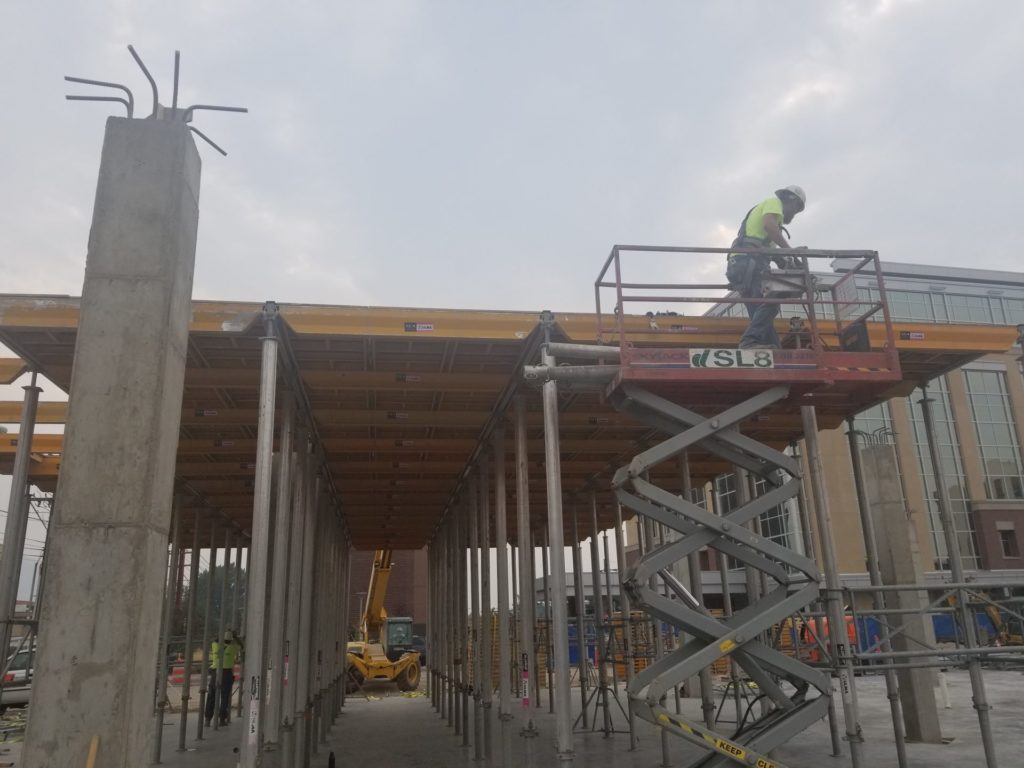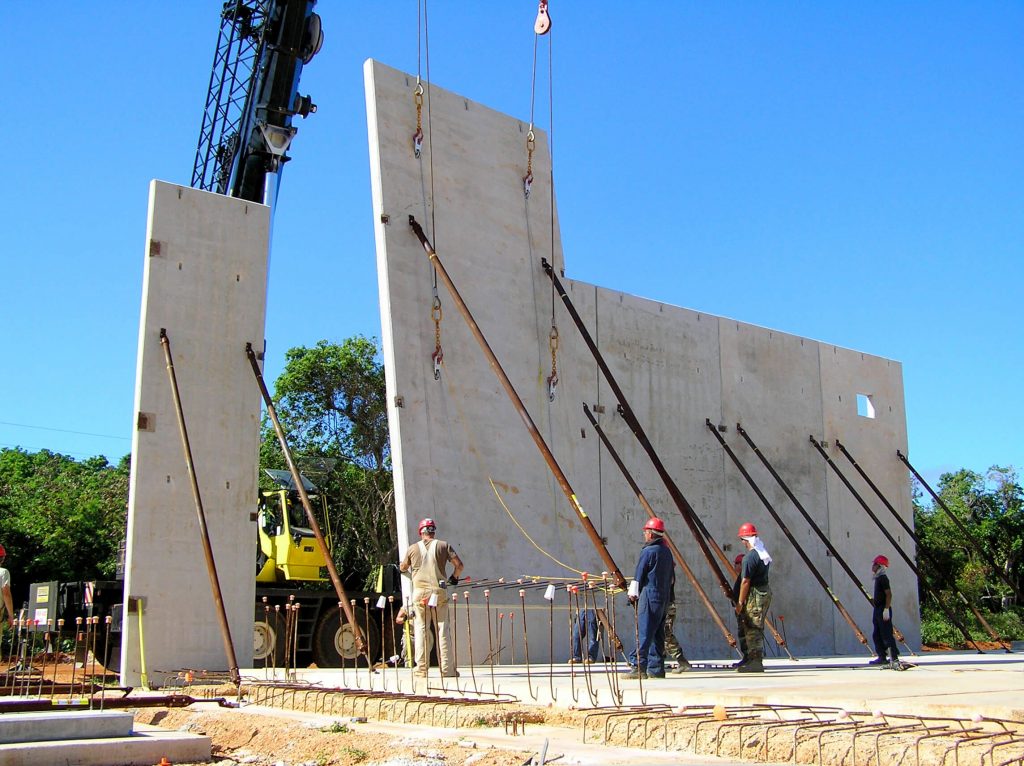On the job site, time is money, and delays can be costly. But what if making a small change could shave days off your schedule while saving big bucks? That’s the premise behind SmartRock Plus™, the concrete slab temperature sensor that allows contractors get real-time information about the strength and temperature of newly poured concrete as it matures.
Explore 12 Futuristic Technology Trends Solving Concrete's Biggest Challenges.
How are Concrete Slab Temperature Sensors Making Construction More Efficient?
SmartRock Plus is manufactured by Giatec Scientific of Ottawa, Canada, but other companies also tout similar products. Giatec’s version uses wireless, 2-by-2-inch battery-powered sensors, which are set into the concrete as it’s being placed. These concrete slab temperature sensors use wireless technology to transmit data that you can read with an Android or iOS smartphone app. The apps draw from data stored in the cloud to analyze the performance of the concrete.
The company suggests embedding one sensor for every 100 cubic yards of concrete. Greg McKinnon, operations manager for Stoneway Concrete, said his company first used the technology last year for R.C. Hedreen Co.’s Hyatt Regency hotel tower. The hotel is under construction at 808 Howell St. in Seattle’s Denny Triangle. Sellen Construction is the general contractor. “We were literally the first to use it in the Seattle market,” McKinnon said. SmartRock Plus paid for itself right away. McKinnon said after the concrete mat foundation was poured it needed to reach a compressive strength of 4,500 pounds per square inch in seven days so the tower crane could be erected on schedule.
How Do Contractors Know When the Concrete Has Reached the Required Strength?
Typically, field technicians cast test cylinders which they send to a lab for analysis. But the concrete in the cylinder may not share all the properties with the concrete that contractors have placed. This happens thanks to variables such as temperature, weather, or improper casting and storage. The results can take a couple of hours to come back from the lab, delaying work. For the hotel tower, contractors using the embedded sensors knew after just five days the mat foundation would be ready on time. The concrete from the pour that they had sent to a lab for analysis still had not achieved the desired strength after nine days.
Using a concrete slab temperature sensor allowed crews to stick to the schedule. But saving costs is not the only benefit to using such technology. There’s an environmental benefit, too. SmartRock Plus offers a “greater opportunity to select the mix that will perform the best with the least cost and environmental impact,” McKinnon said. For example, engineers could use the performance data to formulate mixes that use less additional content, he said. Despite the potential upsides, SmartRock Plus and similar products face a couple of hurdles to achieving wider use. McKinnon said the product adds $1 to $2 per cubic yard for big paving jobs “and considerably more for smaller jobs.”
Measuring Concrete Strength: Cylinder Testing vs. Maturity Testing
There is also the issue of contractor acceptance, since concrete slab temperature sensors are a departure in more ways than one. Cylinder testing, despite its common use, does not measure the strength of the concrete in the structure. Instead, it is about whether the concrete producer batched the right material. The testing involves the use of a machine that breaks the concrete cylinders. One can calculate the compressive strength from the failure load divided by the cross-sectional area resisting the load. The critique from Giatec, the maker of SmartRock Plus, is that this method is not necessarily accurate. Giatec’s embedded sensors use a different method based on maturity, another well-established testing concept. The sensors measure the internal temperature of the mix (which can heat up from chemical reactions), and estimate the in-place strength of the concrete based on the mix design.
The industry standards and practices group, ASTM, identifies several limitations of the maturity method. This includes that said method should be supplemented by other strength tests such as breaking cylinders. Still, Giatec says in a report that the maturity method can “potentially address many immediate challenges facing the concrete industry such as predicting appropriate time for formwork stripping and post-tensioning, especially at low temperatures while the strength development of concrete is hindered; and optimizing concrete mix design and concrete curing conditions.” McKinnon had trouble coming up with any projects where he would not use SmartRock Plus. Indeed, he used it for 40 projects in the last year. “We really like their company philosophy. We signed a deal and started implementing their product, ” he said. Stoneway sought out Giatec after becoming interested in its technology and its potential to improve their efficiency.
Learn More About the Maturity Method Here!
The Concrete Slab Temperature Sensor Revolutionizing the Industry
Giatec CTO, Aali Alizadeh, said one of the company’s key insights was that it made more sense to work with ready-mix suppliers instead of general contractors since the former were responsible for concrete production. The company had been selling a sensor directly to contractors at first. What is more, suppliers can monetize the performance data for their mixes by marketing it as a value-added solution for contractors.
Changing this industry will take a long time. It allows the contractor to make better decisions with respect to their schedule, which can eventually save money. Aali R. Alizadeh, CTO, Giatec
Sarah McGuire, head of sales for Giatec, said the company has around a half-dozen customers for SmartRock Plus, which it started marketing a year ago. Stoneway was the first to bite. Contractors can be slow to adapt to new technologies, Alizadeh said, so he’ll have to spend time educating the market on how the system works. A company report says the industry prefers the cylinder method “due to the upfront cost of concrete mixture calibration for maturity (calculations), and the lack of expertise for the installation of a concrete slab temperature sensor, data collection and analysis.”












One Response
It’s great to see what technology can do these days–it can now measure how long a slab of concrete has been sitting and inform you when it has reached its maximum curing time and when it has set. Now that technology has reached this kind of level, more contractors can now focus on other important things that they can turn their attention to while waiting for the concrete to dry. If I had a chance to try the application, then I would at least give it a spin to see whether or not it really works.